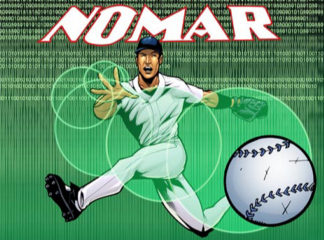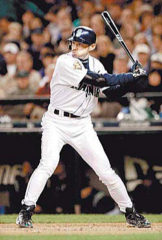|
Is any modern player likely to break the record? I guess you didn't read the earlier pages. The answer is no. The reason is that even if Joe DiMaggio could come back and hit as well as he did in 1941 for the next several thousand years, he would not be likely to duplicate the streak of 56. Ever. It was a fluke. It was nearly a miracle. Maybe it was a miracle in a time that needed one. No modern player is as likely to hit in 56 consecutive games as Ty Cobb or George Sisler or Rogers Hornsby. No modern player is anywhere near that likely, and yet even those players never came close to 56. There are some modern players who have as good a chance as DiMaggio had, or better.
|
|||||||||||||||||||||||||||||||||||||||||||
|
Albert Pujols Pujols is DiMaggio. There is no significant difference between the overall performance of the two players in their first three years in the show, but DiMaggio, playing for the high scoring Yankee offenses of the late 30s, got 4.66 plate appearances per game in that period. He had Lou Gehrig batting behind him, and Bill Dickey in the same line-up, for heaven's sake. Pujols gets 4.2 chances per game. That difference in opportunities makes Pujols less likely to hit in a streak. Check out these stats for their first three years in the majors, based on the average per season: |
|
||||||||||||||||||||||||||||||||||||||||||
But now look at Pujols in 2003 compared to DiMaggio in 1941, the actual year of the miracle streak.
The difference between them has narrowed to near parity. Pujols was about as likely to produce a streak last year as DiMaggio was in 1941. Pujols had 95 chances in a million of a 56 game streak last year, which sounds quite limited until you realize that DiMaggio had only 133 chances when he actually did it. Some "what-ifs" related to Pujols's chances for a 56 game streak.
|
|||||||||||||||||||||||||||||||||||||||||||
|
Ichiro Suzuki The way Ichiro played in 2001, coupled with the fine play of the Mariners in general in that year, coupled with the fact that he batted in the lead-off spot, made Ichiro the top recent candidate to beat the streak. That would continue if he can recreate his context from 2001. Ichiro was ten times more likely to produce a 56 game streak in 2001 than DiMaggio was in 1941. Don't get too excited. That sounds impressive, but it merely means he had one chance in 750 instead of one chance in 7500. Don't lose sight of the fact that DiMaggio's streak was a miracle. |
|
||||||||||||||||||||||||||||||||||||||||||
As you can see, Ichiro has more games to work with than DiMaggio had, and he is less likely to produce a hitless game. Unfortunately, Ichiro did not continue to play at that level. The 2003 chart is far less impressive.
Two negatives kicked in between 2001 and 2003. First, Ichiro's success rate dropped below DiMaggio's. Second, the Mariners were not as good, so Ichiro's rate of plate appearances per game suffered, dropping to a level about identical to DiMaggio's. But if he could return to 2001 standards, Ichiro would have a chance, at least as good as chance as DiMaggio, or better. |
|||||||||||||||||||||||||||||||||||||||||||
 |
Nomar Garciaparra
In the year 2000, Nomar had an HPA of 33.4%. Last year (2003), he played in 156 games and averaged 4.47 plate appearances per game. If he could ever do those things in the same year, he would be six times more likely to produce a 56 game streak than DiMaggio was in 1941. Of course, that still leaves him fighting against 1200-1 odds, but DiMaggio beat tougher odds. It could be done. |
||||||||||||||||||||||||||||||||||||||||||

